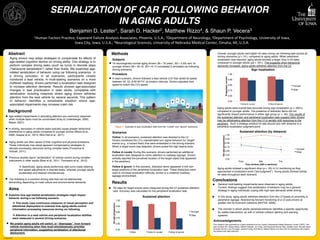
DA poster_2015_serialization_2.1
- 1. SERIALIZATION OF CAR FOLLOWING BEHAVIOR IN AGING ADULTS Benjamin D. Lester1, Sarah D. Hacker2, Matthew Rizzo4, & Shaun P. Vecera3 1Human Factors Prac/ce, Exponent Failure Analysis Associates, Phoenix, U.S.A.; 2Department of Neurology, 3Department of Psychology, University of Iowa, Iowa City, Iowa, U.S.A.; 4Neurological Sciences, University of Nebraska Medical Center, Omaha, NE, U.S.A. In each scenario, drivers followed a lead veh50, 55, & 60 M.P.H. at random intervals. Drivers adjusted their speed to match the LV’s speed. Abstract Aging drivers may adopt strategies to compensate for effects of age-related cognitive decline on driving ability. One strategy is to perform complex driving tasks (such as turns) in discrete steps (“behavioral serialization”) rather than fluidly. We examined age- related serialization of behavior using car following scenarios in a driving simulator. In all scenarios, participants closely monitored a lead vehicle. In multi-tasking scenarios on a more cluttered roadway, drivers performed a localization task designed to increase attention demands. Results showed age-associated changes in task prioritization in older adults, compatible with serialization including instances where aging drivers withdrew attention from the lead vehicle for several seconds. This pattern of behavior identifies a remediable situation where age- associated impairments may increase crash risk. Background Age-related impairments in allocating attention are commonly observed when multiple tasks must be coordinated (Kray & Lindenberger, 2000; Mayer, 2001). Examine how age-related serialization strategies might impact behavior during a car following scenario. Methods Results Conclusions General multi-tasking impairments were observed in aging adults. Current findings suggest that serialization of behavior may be a general strategy in aging individuals coping with high task demands while driving. In this study, aging adults withdrew attention from the LV based on proximity to peripheral signage. Abandoning forward monitoring of a LV puts drivers at greater risk for front-end collisions (NHTSA, 2009). The manner in which adults serialized behavior identifies a specific opportunity for safety intervention, as with in vehicle collision alerting and warning systems. Acknowledgements This research was supported by a grant awarded from the Toyota Collaborative Safety Research Center (CSRC). We wish to thank Drs. Nazan Aksan, Satoshi Kitazaki, Jim Foley, and Kazutoshi Ebe for their valuable input. We also thank Amanda Farmer, Lacy Flanagan, Jessica Ferdig, Rob Marini, Nathan Myhre and Tara Ohrt for assistance with subject recruitment and data collection. Subjects 16 neurologically-normal aging drivers (M = 79 years, SD = 5.95) and 19 younger drivers (M = 30.19, SD = 6.11) completed 3 simulated car following driving scenarios. Procedure In each scenario, drivers followed a lead vehicle (LV) that varied its speed between 50, 55, & 60 M.P.H. at random intervals. Drivers adjusted their speed to match the LV’s speed. Car following is a common driving task that can be attentionally demanding depending on road culture and environmental demands. Figure 1. Example of sign localization task from the “Locate” and “Ignore” scenarios. Hit rates for target events were measured during the LV sustained attention task. Accuracy was calculated for the peripheral localization task In driving, secondary in-vehicle tasks typically cause greater behavioral interference in aging adults compared to younger drivers (Wood et al., 2006; Gaspar et al., 2013; Wild-Hall et al., 2011). Aging adults are often aware of their cognitive and physical limitations. These individuals may adopt apparent compensatory strategies to allocate processing resources during complex tasks (Fovanova & Vollrath, 2011). Previous studies report “serialization” of vehicle control during complex manuevers in older adults (Boer et al., 2011; Thompson et al., 2012) à Specifically, aging adults performing right turns made steering and speed adjustments in discrete steps, whereas younger adults accelerated and steered simultaneously. à This study uses continuous measures of visual perception and attentional deployment to examine how aging adults control information processing resources during car following. Scenarios Follow: In all scenarios, sustained attention was directed to the LV. Drivers monitored the LV’s unpredictable turn signal behavior for “target” events (e.g., a hazard flash) that were embedded in the driving scenario. When a target event was detected, drivers pulled the high beams lever. Follow & Locate: During this scenario, drivers performed an additional localization task designed to mimic attention to roadway signage. Drivers verbally reported the perceived location of the target object that appeared in the periphery. Follow & Ignore: In this scenario, distractor items appeared in the non- target positions of the peripheral localization task. These distractors were used to increase localization difficulty, similar to a cluttered roadway signage environment. 0.50 0.60 0.70 0.80 0.90 1.00 Follow Follow & Locate Follow & Ignore Hitrate(proportion) Sustained attention Younger Older Overall, younger adults had higher hit rates during car following task across all driving scenarios (p < .01), compared to aging adults. When peripheral localization was required, aging adults showed a larger drop in hit rates, compared to younger adults (ps < .001). This suggests when behavioral demands increased, aging adults withdrew attention from the LV. 0.50 0.60 0.70 0.80 0.90 1.00 Follow & Locate Follow & Ignore Proportioncorrect Sign localization Younger Older Aging adults were overall less accurate during sign localization (p < .0001), compared to younger adults. The presence of distractor items did not significantly impact performance in either age group (p > .05). The results of the sustained attention and peripheral localization task suggest older drivers may be withdrawing attention from the LV to serially shift resources to the periphery. Such a strategy predicts hit rate should vary with distance to a peripheral localization judgment point. 0.40 0.50 0.60 0.70 0.80 0.90 1.00 Post- Mid- Pre- Hitrate(proportion) Time window (300 m sections) Sustained attention (by distance) Younger Older Aging adults showed a significant drop (p < .05) in LV monitoring as they approached a localization point (“pre-judgment”). Young adults showed similar hit rates throughout each scenario. Z150287-8676 Aims à Attention to a lead vehicle and peripheral localization abilities were measured in several driving scenarios. We predict aging adults will switch, or “disengage”, from forward vehicle monitoring when they must simultaneously prioritize peripheral information, suggesting serialization of attentional deployment.
